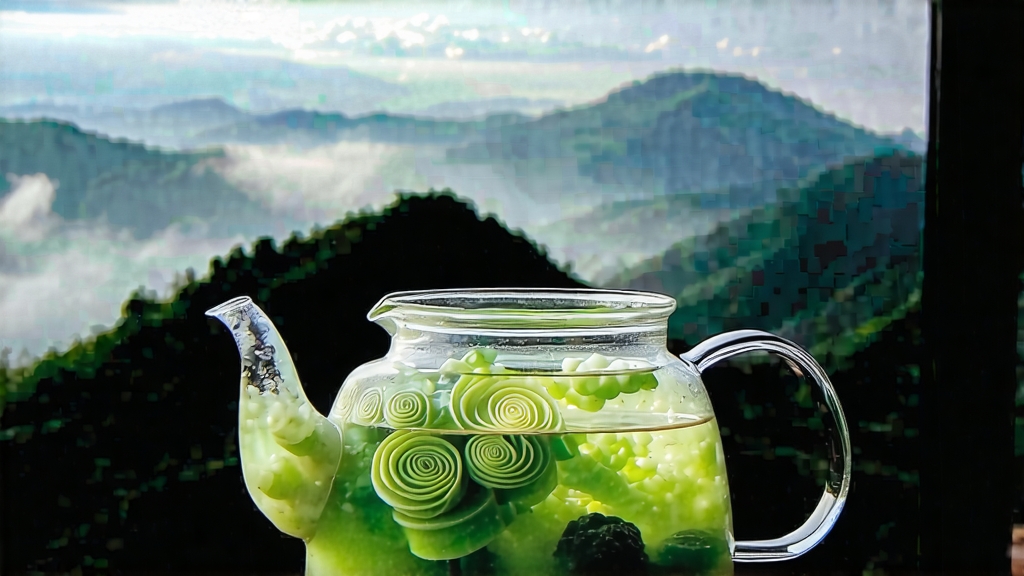
Tucked between the mist-laden peaks of Dongting Mountain in Jiangsu Province and the vast mirror of Taihu Lake lies the birthplace of Biluochun, a green tea so delicate that one gram contains roughly sixty neatly spiraled buds. To international drinkers accustomed to the grassy punch of sencha or the nutty warmth of gunpowder, Biluochun offers a softer, almost flirtatious introduction to Chinese greens: a liquor the color of early morning sunlight, an aroma that somehow marries ripe peach with fresh orchid, and a finish that lingers like a whispered secret. Yet behind this elegance stands a history of imperial craving, maritime trade, and painstaking craft that stretches back to the late Ming dynasty.
Legend credits a tea-picking nun who wandered the Dongting slopes in 1675. While gathering wild shoots she tucked excess buds into her bodice, only to discover hours later that body heat had lightly oxidized them, unlocking an intoxicating perfume. Local monks refined the accidental technique, and the tea—first named “Xia Sha Ren Xiang” (literally “scary fragrance”)—so enchanted the Kangxi Emperor during his southern inspection tour of 1699 that he rechristened it Biluochun, “Green Snail Spring,” referencing its spiral shape and early-spring harvest. Court chroniclers record that the imperial caravan carried thirty small crocks of the tea northward, each sealed with yellow silk and guarded by eunuchs who slept with the jars to keep them warm during frosty nights on the Grand Canal.
Today the name covers two legally protected appellations: Dongting Dongshan (East Mountain) and Dongting Xishan (West Mountain), both islands in Taihu Lake. Within these micro-zones growers recognize three sub-styles. Quanfeng (Full Bud) consists solely of the terminal shoot, plucked when the leaf tip is still unfurled and the downy silver hairs lie flat against the stem; it delivers the most nuanced fragrance but demands 72,000 buds per 500 g. Yafeng (Elegant Bud) keeps the first tiny leaf attached, adding a greener, slightly brothy note. Cuifeng (Emerald Peak) includes two leaves, yielding a bolder liquor favored in the export market for its lower price and stronger shelf life. Regardless of grade, true Biluochun must be harvested before the Qingming festival, when daytime temperatures hover around 14 °C and the lake’s evaporative mist acts as a natural shade cloth, boosting chlorophyll and amino acids while suppressing bitter catechins.
The crafting choreography begins the same evening picking ends. Fresh baskets are wheeled into a shed where bamboo trays rest only one bud deep; fans draw in cool night air to reduce surface moisture without wilting the cells. At dawn the shaqing (kill-green) wok is heated to 180 °C, its cast-iron surface brushed with a mixture of fresh tea-seed oil and local pear juice—an old trick that seasons the metal and adds a faint fruity primer. A shaifu (master fryer) tosses 250 g of buds in a figure-eight motion lasting precisely 4.5 minutes, cool enough to preserve the jade color yet hot enough to rupture the cuticular wax so that aromatic aldehydes can later escape. The leaves exit at 60 % moisture, pliable as silk ribbons.
Immediately they are transferred to a second wok held at 70 °C for cuonian (initial rolling). Here the shaifu’s palms press and flick in alternating circles, coaxing the buds into tight spirals while redistributing cellular juices to the surface. After eight minutes the tea resembles thousands of miniature snail shells, each coated with a downy bloom. A third wok at 50 °C completes the hongbei (final drying), during which the master listens for the tell-tale rustle that signals 6 % residual moisture. The entire trilogy—shaqing, cuonian, hongbei—must finish within 40 minutes; any delay oxidizes the leaf edges, muting the signature magnolia note.
To appreciate such labor in the cup, western drinkers need only remember three numbers: 3, 75, 30. Use 3 g of tea for every 150 ml of water, heat the water to 75 °C (not the rolling boil we reserve for black tea), and limit the first infusion to 30 seconds. A tall glass is traditional in Suzhou teahouses because it allows